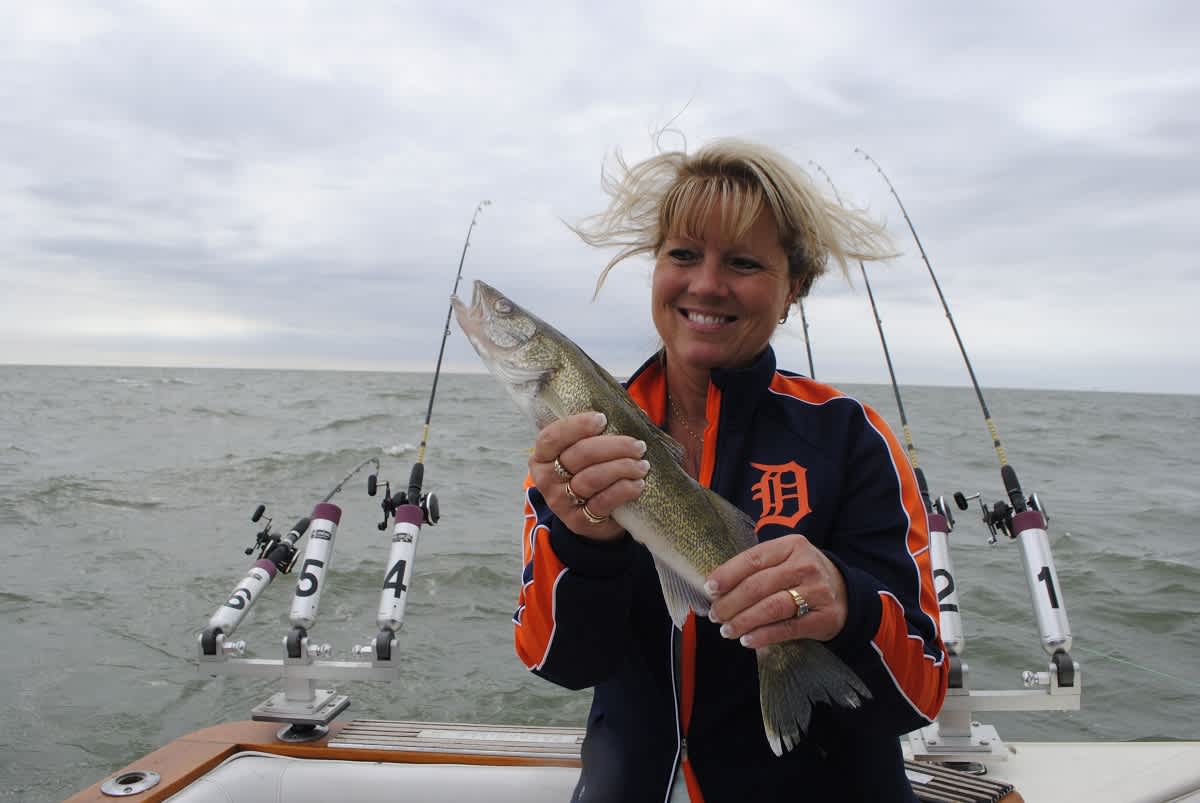Keeping It Local for Lake Erie Walleye
Bob Gwizdz 07.02.14

This is the time of year, when spring transitions into the dog days of summer, that many anglers abandon the Michigan waters of Lake Erie and head to Ohio water to fish.
Not Ray Underwood.
“I’m a firm believer that there are always walleye in the Michigan waters of Lake Erie,” Underwood said.
And everyone aboard—largely Department of Natural Resources Wildlife Division personnel on what has become an annual outing—were just as glad we weren’t making a long run to Buckeye water as the big lake was acting rather unfriendly. There were three- to four-footers, rolling the 39-foot Sea Ray around like a rubber ducky.
We didn’t have to run for very far before Underwood cut back the engine and Joe Robison, a wildlife biologist who serves as Underwood’s first mate on these fun-fishing excursions, let out he planer boards and began setting lines. We were fishing along the edge of the Michigan Dump, where spoils from dredging operations were deposited many years ago. What had been 20 feet of water came up to 14 feet quickly and Underwood was determined to fish along the edge.

“You can catch fish in there, but when you get into the Dump, there are so many up and downs that you tend to lose a lot of lures,” Underwood explained. “You’ll be going along for a half a mile and it’ll be 12 feet deep, then it’ll come up to eight feet before you know it.”
Because of the changing depth along the edge, Underwood opted for crankbaits, which ride a little higher in the water column than the jet diver/spoon rigs he’s used the last several years this crew has fished with him. It necessitated a slower troll, he said, but we started catching fish right away. Thing is they weren’t walleyes. They were white bass. That’s not unusual, as the whites are everywhere this time of year.
But it wasn’t too much longer before we started catching ‘eyes. It was a fairly slow bite, complicated by the rolling seas (which only built as the morning progressed) that turned steering the boat into a wrestling match to keep it on-course. The waves had more than a couple of the guests turning a bit green about the gills.
The fish were taking Wiggle Warts, a pretty standard Lake Erie bait. We probably had 10 different colors out there and none seemed to shine any more brightly than the others as we trolled them 70 to 80 feet back of the planer board lines.
“With the Wiggle Warts we have to troll a little slower—two to 2.1, 2.2 miles an hour,” Underwood said. “Spoons we’ll run 2.5 to 2.7. But if we run the Wiggle Warts that fast, they run erratically.”
We weren’t having any trouble hooking walleyes, but putting them into the boat was another matter. The fish would come to the surface and the crashing seas would seemingly knock them off the lures. We boated about half of what we hooked, which was less than half of what a typical trip incurred two decades ago.
The fish we were catching, however, were beauties, around 20 to 22 inches, by my eyeball ruler, perfect for grill or fryer. All of them seemed to be from the same year-class.
As the seas built—there were five-footers, maybe more, rocking the ship—and some folks aboard began to look even greener, the bite slowed. When we went nearly an hour without a strike, the captain suggested we call it a day. I didn’t hear anyone object.
We wound up with 13 ‘eyes for about four hours of fishing. Not great by Erie’s historical standards, but better than most other places anywhere, especially considering the conditions.
“This lake has awesome production of walleye and perch,” Underwood said. “If you look at the tons of fish that come out of the Canadian commercial fishery and all the fish the recreational anglers take, it’s amazing.”
Indeed. If you’re old enough to remember when Lake Erie was considered dead, the walleye fishery in Lake Erie is, as Underwood put it, “amazing.”
For more information on Michigan fishing go to michigan.org. Click here to purchase a Michigan fishing license online.
This article was produced in partnership with Pure Michigan.

